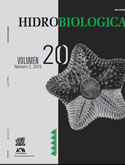Community and trophic structure of sea stars (Echinodermata: Asteroidea) in rocky reefs of Loreto, Gulf of California, Mexico
Keywords:
Echinodermata, rocky reefs, Bahía de Loreto National Park, ecological indices, trophic guilds.Abstract
Sea stars (Asteroidea) are invertebrates with remarkable importance in rocky and coral habitats as they occupy several levels in trophic webs, and many times act as top predators in these ecosystems. The taxonomic and biogeographic knowledge about this group in México is adequate, but there is still limited information on the ecology and functioning of its assemblages. The objective of this study was to compare the community and trophic structure of rocky bottom asteroids in two regions of the Gulf of California: Loreto and Ligüi (25.5° to 26.5°N). Individuals were censused in belt transects 25 × 2 m (N = 106, at depths from 3 to 12 m), abundance, species richness, diversity (H´) and evenness (J´) was estimated, as well as the number of seastars per trophic guild (carnivores, herbivores and detritivores), and of guilds present per transect. The results indicate that starfish assemblages in both zones were dominated by the species Phataria unifascialis, and that Loreto had significantly higher richness, abundance and diversity of asteroids than Ligüi,probably as a consequence of higher number of habitats and food resources. In relation to the trophic composition, in both areas herbivores predominated, followed by detritivores and finally by carnivores. Abundance in each trophic level was statistically higher in Loreto, and also there were more trophic groups per transect at that location.Downloads
Downloads
Published
How to Cite
Issue
Section
License
Los autores/as que publiquen en esta revista aceptan las siguientes condiciones:
De acuerdo con la legislación de derechos de autor, HIDROBIOLÓGICA reconoce y respeta el derecho moral de los autores, así como la titularidad del derecho patrimonial, el cual será cedido a la revista para su difusión en acceso abierto.
Publicar en la revista HIDROBIOLÓGICA tiene un costo de recuperación de $500 pesos mexicanos por página en blanco y negro (aproximadamente 29 dólares americanos) y $1000 pesos por página a color (aproximadamente 58 dólares americanos).
Todos los textos publicados por HIDROBIOLÓGICA sin excepción se distribuyen amparados bajo la licencia Creative Commons 4.0Atribución-No Comercial (CC BY-NC 4.0 Internacional), que permite a terceros utilizar lo publicado siempre que mencionen la autoría del trabajo y a la primera publicación en esta revista.
Los autores/as pueden realizar otros acuerdos contractuales independientes y adicionales para la distribución no exclusiva de la versión del artículo publicado en HIDROBIOLÓGICA (por ejemplo incluirlo en un repositorio institucional o publicarlo en un libro) siempre que indiquen claramente que el trabajo se publicó por primera vez en HIDROBIOLÓGICA.
Para todo lo anterior, el o los autor(es) deben remitir el formato de Carta-Cesión de la Propiedad de los Derechos de la primera publicación debidamente requisitado y firmado por el autor(es). Este formato se puede enviar por correo electrónico en archivo pdf al correo: enlacerebvistahidrobiológica@gmail.com; rehb@xanum.uam.mx (Carta-Cesión de Propiedad de Derechos de Autor).
Esta obra está bajo una licencia de Creative Commons Reconocimiento-No Comercial 4.0 Internacional.


